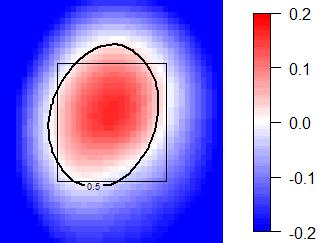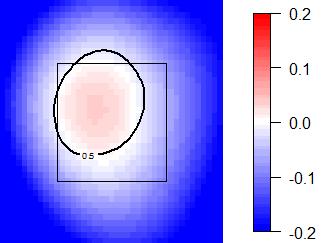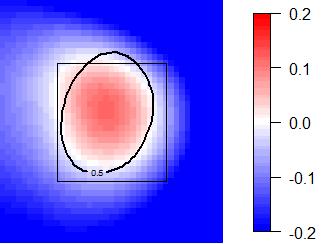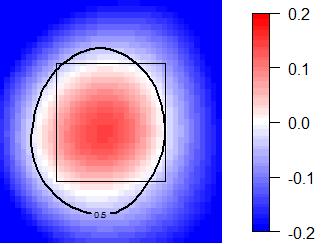
| Touching Bases | October 16, 2010 |
There's been some discussion over at The Book Blog on whether or not batters swing too often at full count pitches. For me, this line of thought started when I read Dave Allen's research that showed that batters are more likely to swing 3-2 than 2-2. I'll get back to Dave's work in a moment, but first an aside on my theoretical understanding of the situation.
In equilibrium, pitchers want to throw strikes at such a rate that batters are indifferent toward swinging. The way I've figured it, and I really might have figured it wrong, that means that on 0-2 and 1-2 counts, pitchers want to throw at least 80% balls, while on 3-0 and 3-1 counts, they want to throw at least 70% strikes. In turn, that means that batters want to swing at 0-2 and 1-2 counts when they are at least 20% sure that a pitch is a strike and take on 3-0 and 3-1 when they are at least 30% sure that a pitch is a ball. The benefit of taking a pitch on 3-2 is obviously much greater than it is on 2-2, as the reward of a ball is a walk. What I've found unique about the 3-2 count, and again, my theoretical prediction might be off, is that it is the only hitter's count that dictates that pitchers throw more balls than strikes and that batters swing at pitches that are probably balls.
Back to Dave's work, because it turns out that he did a followup study asking, "do batters swing too often in a full count?" Dave showed the difference in value between taking a pitch and swinging at a pitch based on pitch location. The area in which batters are just as well off swinging as they are if they were to take should also be the area where batters swing 50% of the time. However, on a full count, batters swing 75% of the time in that area, according to Dave's research. I really like his methodology, and to me it is proof that batters do swing too often on full counts. Unless I'm missing some flaw, which is why I tried to repeat Dave's process at the player level.
The first player I tried was Albert Pujols, and he proved to be a good test case.

Red means swing, blue means take, and white means indifference. The black contour line estimates the player's 50% swing rate.
The best hitter in the game seems to know exactly when he should be indecisive, so to speak.
My hope was that this type of analysis would vindicate guys like Vladimir Guerrero and Brett Gardner, above average hitters with unique hitting styles. Unfortunately, the data indicate that Vlad swings at too many pitches out of the zone and Gardner at too few. It's easy to say that Jeff Francoeur should learn to take a pitch, but to offer such advice to Vlad is tricky, and probably wrong. And if umpires didn't call such an absurd strike zone to Gardner, it's possible that he would be correct to swing so little.
One hitter who never swings, and correctly so, is Elvis Andrus. He must recognize his historic lack of power.

And J.D. Drew knows where his bread is buttered.

It was difficult to find evidence of any batter who should swing at pitches out of the strike zone. I was hoping that would be the case with Vlad. Miguel Cabrera is one such batter who might have good reason to be a free swinger.

And lastly, Colby Rasmus is the most extreme low-ball swinger in the league, and this type of graph shows that he's also a low-ball hitter.

I like the type of information that these charts display. Using it as a prescriptive tool to say how often a specific batter should swing would be wrong, but I continue to think that on a league-wide level, batters swing too often on full counts.
Comments
To know whether hitters are swinging too much at 3-2 counts, or any count, you will need to consider a lot more information. First, the swing/take categories are extremely crude. For example, if hitters were only marginally better off taking balls on the inner part of the blue, but much better off swinging at the outer parts of the red, then it could easily make sense to swing more than 50% of the time outside the white band. Or vice-versa.
Second, you need to consider the distribution of pitches in various locations -- without that, your really can't reach any conclusions at all.
Third, you need to know how the distributional impact of increasing a hitter's overall take rate. For every extra pitch taken in the red zone, how many does he take in the blue zone. And more specifically, what are the net run values of all the extra takes, compared to when the hitter swung?
IOW, this is really complicated. But here's a simple way to think about it: when hitters swing 3-2 now, they have a wOBA of .293. If the hitter takes a marginal pitch, what happens? In the pool of pitches currently swung at, about 73% are strikes. So let's say the marginal take is a strike 67% of the time. A 33% BB/ 67% K outcome isn't better than hitters now achieve with a swing. If hitters do swing too much, it can't be by very much.
Posted by: Guy at October 17, 2010 9:56 AM
Sorry, Guy, I don't follow.
Posted by: Jeremy Greenhouse at October 17, 2010 10:44 AM
Don't follow which part?
Posted by: Guy at October 17, 2010 11:01 AM
What I think would answer the question is to impose the 2-2 hitter behavior on the 3-2 pitch distribution. At 2-2 hitters take a bit more often. So find out what would happen at 3-2 if hitters swung at same rate, and with same outcomes, at pitches in each location. I think you would need to limit the analysis to fastballs, because hitters would see a lot more breaking balls at 2-2.
Posted by: Guy at October 18, 2010 5:24 AM
I'd be interested in seeing how far from optimal some of the extreme hitters like Vlad and Gardner are.
Posted by: Telnar at October 19, 2010 6:46 AM